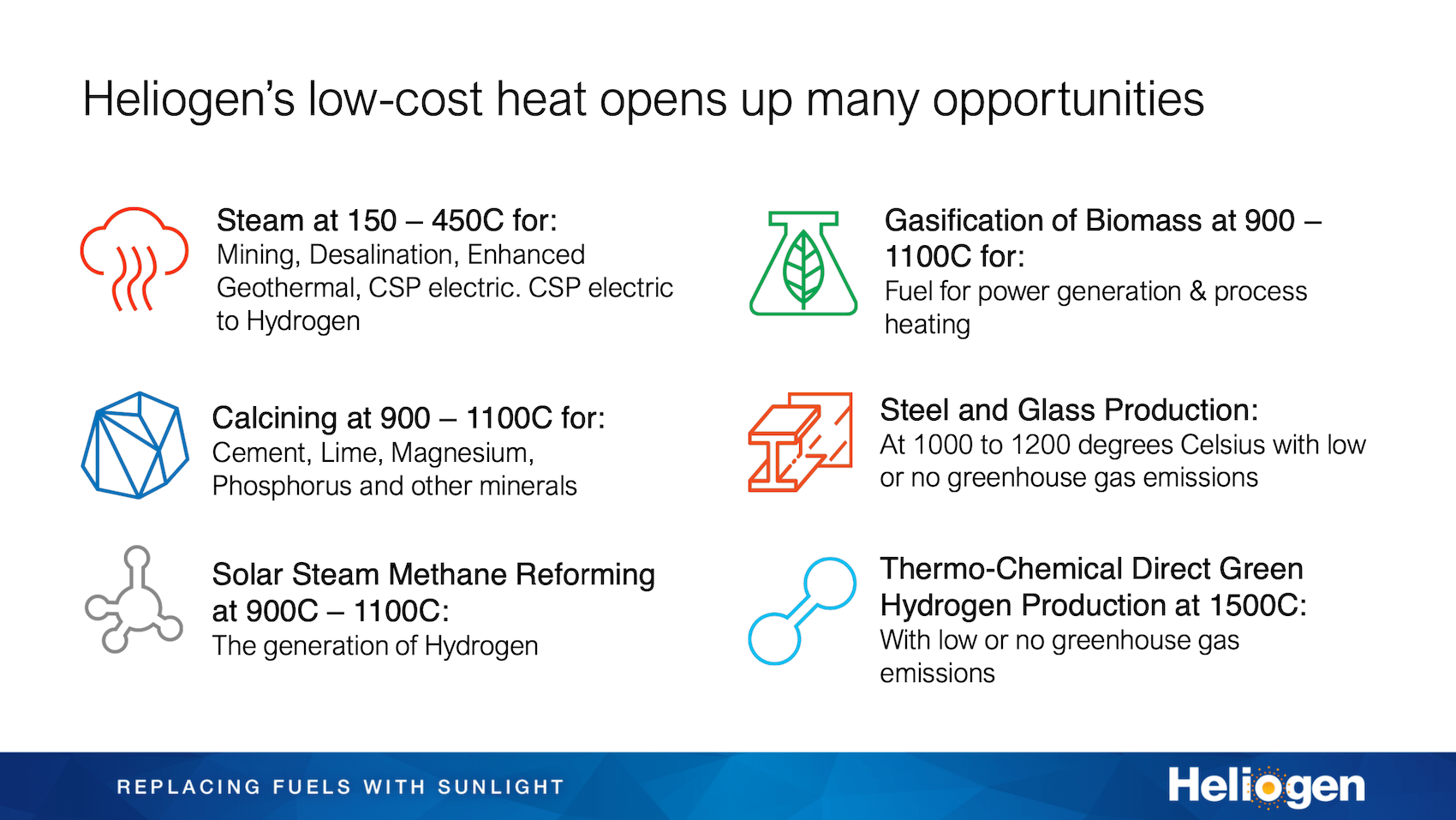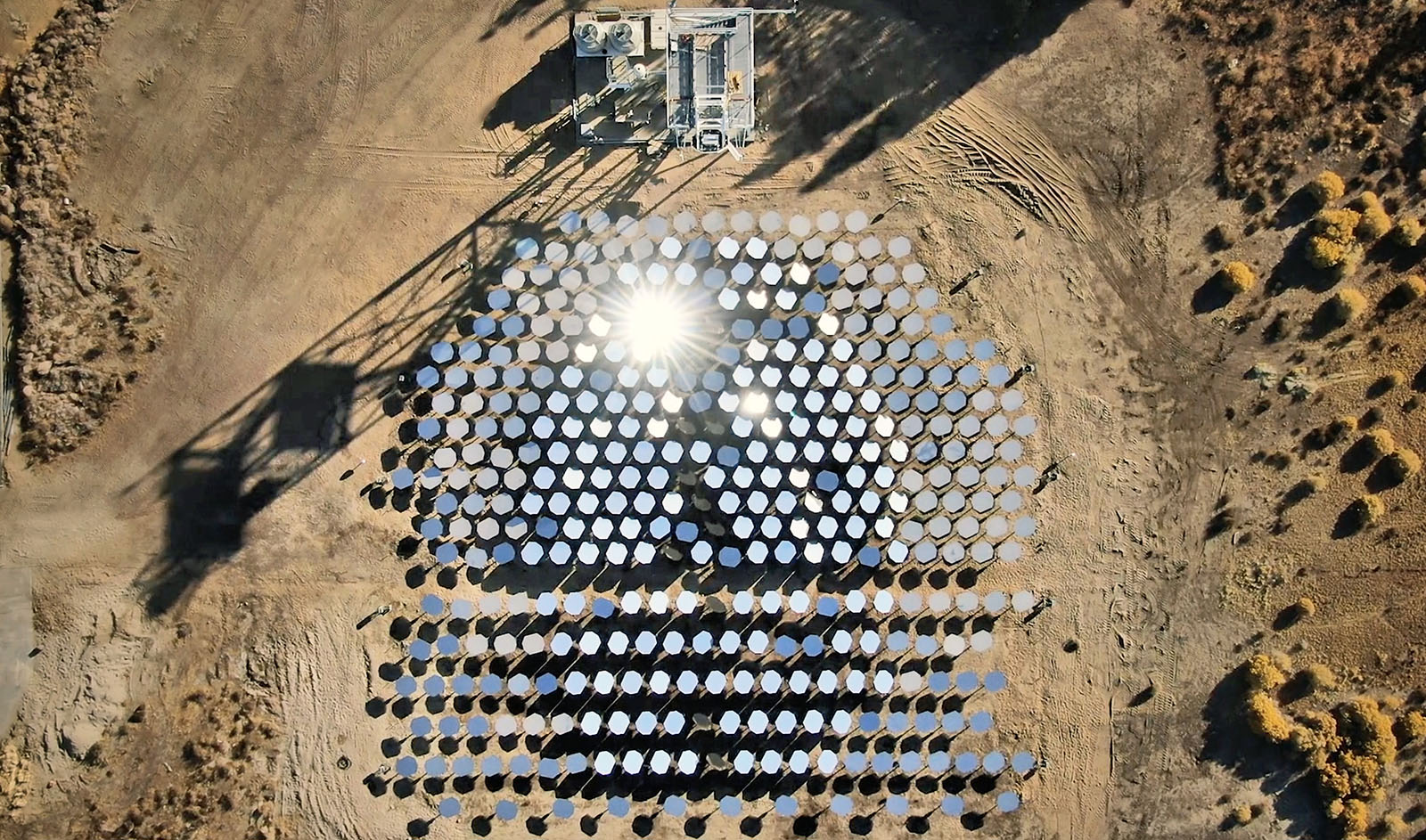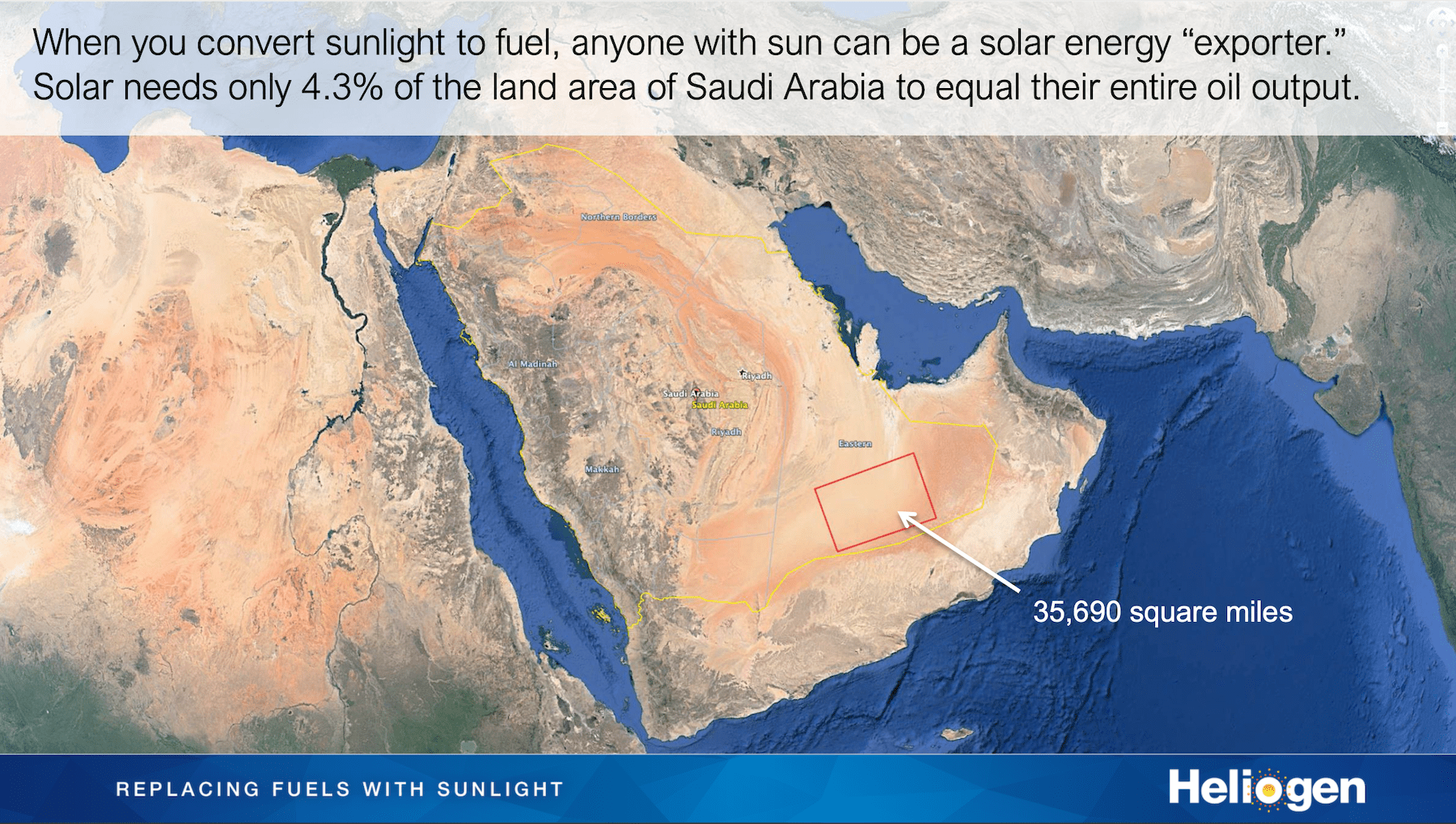
IMAGE@Heliogen
Well before Bill Gross started Idealab (which has launched 150 startups and counting) to “look for big problems in the world, invent technological solutions, then build companies to fix them” he was doodling designs for the solar thermal mirrors that reflect concentrated sunlight onto a solar receiver, instead of attending to his high school English class.
With climate change bearing down ever more insistently on the human species, one big problem the world must fix is cutting the cost of clean energy to supply heat to the industries with over 20% of all greenhouse emissions like cement, steel, fertilizer and hydrogen that now depend on fossil energy for heat.
So Gross founded Heliogen, with seed funding from Bill Gates, and revisited his high school obsession, trying 500 possible solar collector (heliostat) designs, because the cost of the solar field is one of the biggest challenges in making concentrated solar thermal (CST) cheap.

Heliogen’s polygon shaped heliostats in a solar field IMAGE@Heliogen
The US Department of Energy’s Avi Shultz noted during the international 2020 SolarPACES Conference (held online for the first time in October) that solar heat must come down to 2 cents to compete with fossil heat: “We’re targeting 2 cents/kWh-thermal, which we believe is generally competitive with natural gas, although there is a high degree of variation, based on location.”
In his plenary presentation at the conference, Gross broke the news that Heliogen will be even more competitive than this, delivering heat at just 1 cent per kWh. (Nuclear averages 3 cents and natural gas in the US, with the world’s lowest gas prices, is as low as 1.5 cents.)
How Heliogen cut costs to 1 cent
“Farming was kind of our inspiration; big tractors rolling along planting millions of seeds over square miles as opposed to today’s big construction project. Make each heliostat smaller – about the size of a PV panel, about 2 sq m – and you can just drop them off like seeds and they would self-organize. They can receive the signal of where they’re supposed to be from the central control system.”
Once the software from the cameras on the tower “sees” where each heliostat is facing, software “tells” the motor how to reposition the mirrors to aim the focused sunlight up to the receiver correctly.
The motor moving each heliostat only takes about 2 watts, which would be supplied by PV. A low voltage wire loop would run between heliostats like Christmas lighting. And because they’re so much smaller and lighter than typical heliostats they self ballast on waist-high tripods. This cuts costs compared to today’s solar fields’ massive earthworks and concrete foundations.
Another cost reduction is due to size: a typical heliostat might be a hundred square meters with perhaps 100 separate one square meter mirrors and every mirror must be aligned very accurately. A lot of research goes in to avoiding spilled solar due to inaccurately reflected sunlight between the heliostats and the receiver on the tower.
“But we don’t have a canting error because we don’t have any facets. Each mirror is individually controlled. So there is no adjustment or a calibration of an individual mirror because each one is always moving with its own separate motor and that gives us much more accuracy,” Gross said.
Licensing and technology partners
Heliogen is licensing all of the related technologies of the system – the heliostat blueprint itself, along with the mechanics, software, and tracking to run it. But the firm is open to a variety of market approaches.
“Some people have come to us and said we would like you to build the plant and operate it for us and just sell us the heat. We’ll do that. Some have said we want to buy the plant, we want to own it outright and we’d like you to help manage it, we’ll do that. Others have said we’d like to license the heliostat technology and then we’ll build it ourselves,” he commented.
For the remainder of the high temperature system, international researchers, research lab spin-offs, large industrial players and research labs among the SolarPACES member nations are already in various stages of inventing the very high temperature receivers or reactors to turn the sunlight reflected off the heliostats into heat, and the very high temperature thermal energy storage to store the heat.
Heliogen’s focus is on delivering high temperature heat directly to a receiver. That heat could be used directly in an industrial process, or in a reactor used for producing solar hydrogen.

IMAGE@Heliogen
“Obviously you can make electricity with PV panels, and that’s great. But the world needs fuels, it needs fuel for planes, fuel for ships and fuel for steel and cement and everything. Heat is actually 75% of the world’s energy needs, electricity is only 25%,” he noted.
“So I’m trying to come up with the way that we can help the world of building materials and transportation that can’t work on electricity. Some steel mills might just reconfigure themselves to burn hydrogen instead of burning coal. And if they do that they can just make it one to one exchange our challenges. We need to make the hydrogen cheaper than coal. But that’s possible with low enough cost solar.”
So which technology partners would Heliogen work with? Advanced high temperature solar is just beginning to be commercialized. For the thermal energy storage, rocks and gravel are the most promising.
Hot rocks and centrifugal receivers
“If you take molten salt past about 600 C it will get ruined, but there’s no risk of harming rocks. They are very cheap, very reliable and you can make them very hot,” he said.
“You can do unlimited cycles because you can make a rock hot, on, and off, a million times, with no degradation. And so we’re focused on that kind of storage, and we’re really excited about it. So we’d use locally available rock.”
To produce direct heat, you don’t need a power block (steam turbine, generator, solar receiver). Instead, a solar reactor uses heat directly from sunlight for use in industrial processes or the thermochemical production of hydrogen or aviation fuel.
For the receiver technology, Heliogen could work with a firm producing particle receivers (which are capable of very high temperatures) like the proven CentRec particle receiver licensed by the DLR spin-off HelioHeat (that we also cover this month).
Solar hydrogen
“We’re very excited to make hydrogen in Western Australia. We’re actually looking to build some plants in Western Australia. They are very progressive and bullish on that as well, maybe more than in the US. We think our biggest business is probably going to be in Australia,” he said.
Gross has found that Western Australian natural gas companies are thinking more to the future; able to see the writing on the wall, unlike their counterparts in the United States. But a recent study found that Texas is also ideally positioned for the production of solar fuels, due to the combination of excellent solar resource and existing infrastructure for transporting fuels to ports for shipping.
“I would say probably the people most bullish on green hydrogen are Australia and Europe. And China is getting there, you know, possibly under a new administration in the United States, we will get there. Saudi Arabia is a country where there’s a trillion dollars of oil exports and you would think well, they never could match that with solar and I was showing how yes, they could, with only four percent of their land,” he noted.
“The Saudis can match a full trillion dollars of exports with green hydrogen, and they are very interested. I spoke with them when I was there in January, and again a few weeks ago, and I’m speaking to senior executives. In Saudi Arabia they’re really opening their minds to this now.”














































